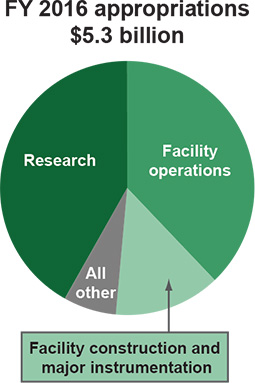The mission of the Office of Science is the delivery of scientific discoveries and major scientific tools to transform our understanding of nature and to advance the energy, economic, and national security of the United States.

The U.S. Department of Energy Office of Science is the lead federal agency supporting fundamental scientific research for energy and the Nation’s largest supporter of basic research in the physical sciences.
The Office of Science portfolio has two principal thrusts: direct support of scientific research and direct support of the development, construction, and operation of unique, open-access scientific user facilities.
These activities have wide-reaching impact. The Office of Science supports research in all 50 States and the District of Columbia, at DOE laboratories and more than 300 universities and institutions of higher learning nationwide. The Office of Science User Facilities provide the Nation’s researchers with state-of-the-art capabilities that are unmatched anywhere in the world.
How We Do Business
The Office of Science manages this research portfolio through six interdisciplinary scientific program offices: Advanced Scientific Computing Research, Basic Energy Sciences, Biological and Environmental Research, Fusion Energy Sciences, High Energy Physics and Nuclear Physics. In addition, the Office of Science sponsors a range of science education initiatives through its Workforce Development for Teachers and Scientists program.
The Office of Science makes extensive use of peer review and federal advisory committees to develop general directions for research investments, to identify priorities, and to determine the very best scientific proposals to support.
The Office of Science Laboratories
The DOE laboratory system is the most comprehensive research system of its kind in the world, and constitutes a critical strategic scientific and technical resource.
The Office of Science has responsibility for 10 of the 17 DOE laboratories, helping to ensure they deliver exceptional scientific productivity benefiting the taxpayer. The ten Office of Science laboratories are: Ames Laboratory, Argonne National Laboratory, Brookhaven National Laboratory, Fermi National Accelerator Laboratory, Lawrence Berkeley National Laboratory, Oak Ridge National Laboratory, Pacific Northwest National Laboratory, Princeton Plasma Physics Laboratory, SLAC National Accelerator Laboratory, and the Thomas Jefferson National Accelerator Facility.
Office of Science User Facilities
One of the defining characteristics of the Office of Science is its support of unique open-access scientific user facilities for the Nation. These open-access facilities—including supercomputers, large particle accelerators, high-intensity x-ray light sources, neutron scattering sources, and facilities for nanoscience, plasma science, genomic sequencing, microbiology, and atmospheric monitoring—are among the most advanced tools of modern science, enabling researchers to explore a host of new scientific frontiers.
The Office of Science has a proud history of achievement in planning, developing, and constructing a wide variety of user facilities on time and on budget. Many thousand researchers from universities, laboratories, private industry, and other federal science agencies used Office of Science user facilities.
Supporting Young Researchers and Students Nationwide
To ensure fulfillment of its mission now and into the future, the Office of Science is committed to cultivating the next generation of scientific talent.
The Office of Science is a principal supporter of researchers early in their careers. The Office of Science supports research at more than 300 colleges and universities nationwide, and roughly half the users at Office of Science user facilities are from colleges and universities. The Office of Science Graduate Fellowship and Early Career research programs also provide opportunities for exceptional young scientists to pursue basic research relevant to the Office of Science.
The Office of Science also reaches out to America's youth in grades K-12 and their teachers to help improve students' knowledge of science and mathematics and their understanding of global energy and environmental challenges.
The Office of Science is the architect and manager of the DOE National Science Bowl®, an educational competition for high school and middle school students involving all branches of science. Each year, the National Science Bowl® attracts over 17,000 students nationwide, challenging them to expand their knowledge of science and mathematics and their understanding of global energy and environmental challenges.
Science for National Need
Advancing a clean energy agenda through basic research on energy production, storage, transmission, and use; advancing our understanding of the Earth's climate through basic research in atmospheric and environmental sciences and in climate modeling; supporting DOE's missions in national security.
Science for Discovery
Unraveling Nature's deepest mysteries, from the study of subatomic particles; to atoms and molecules that make up the materials of our everyday world; to DNA, proteins, cells, and entire natural ecosystems.
21st Century Tools Science: National Scientific User Facilities
Providing the Nation's researchers with the most advanced tools of modern science including accelerators, colliders, supercomputers, light sources and neutron sources, and facilities for studying the nanoworld, the environment, and the atmosphere.